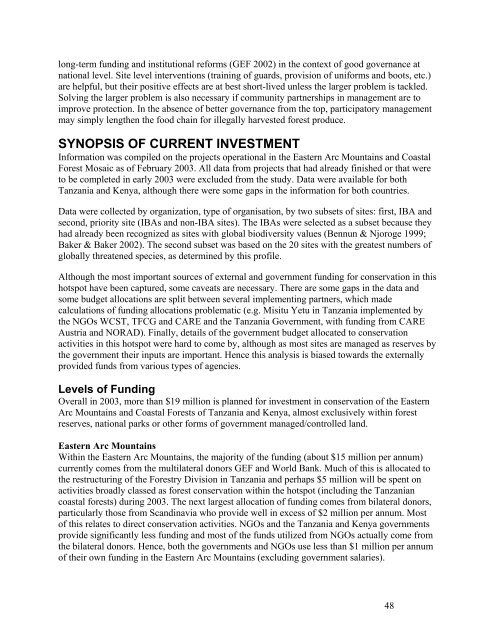Eastern Arc Mountains and Coastal Forests of Tanzania and Kenya ...
Eastern Arc Mountains and Coastal Forests of Tanzania and Kenya ...
Eastern Arc Mountains and Coastal Forests of Tanzania and Kenya ...
Create successful ePaper yourself
Turn your PDF publications into a flip-book with our unique Google optimized e-Paper software.
long-term funding <strong>and</strong> institutional reforms (GEF 2002) in the context <strong>of</strong> good governance atnational level. Site level interventions (training <strong>of</strong> guards, provision <strong>of</strong> uniforms <strong>and</strong> boots, etc.)are helpful, but their positive effects are at best short-lived unless the larger problem is tackled.Solving the larger problem is also necessary if community partnerships in management are toimprove protection. In the absence <strong>of</strong> better governance from the top, participatory managementmay simply lengthen the food chain for illegally harvested forest produce.SYNOPSIS OF CURRENT INVESTMENTInformation was compiled on the projects operational in the <strong>Eastern</strong> <strong>Arc</strong> <strong>Mountains</strong> <strong>and</strong> <strong>Coastal</strong>Forest Mosaic as <strong>of</strong> February 2003. All data from projects that had already finished or that wereto be completed in early 2003 were excluded from the study. Data were available for both<strong>Tanzania</strong> <strong>and</strong> <strong>Kenya</strong>, although there were some gaps in the information for both countries.Data were collected by organization, type <strong>of</strong> organisation, by two subsets <strong>of</strong> sites: first, IBA <strong>and</strong>second, priority site (IBAs <strong>and</strong> non-IBA sites). The IBAs were selected as a subset because theyhad already been recognized as sites with global biodiversity values (Bennun & Njoroge 1999;Baker & Baker 2002). The second subset was based on the 20 sites with the greatest numbers <strong>of</strong>globally threatened species, as determined by this pr<strong>of</strong>ile.Although the most important sources <strong>of</strong> external <strong>and</strong> government funding for conservation in thishotspot have been captured, some caveats are necessary. There are some gaps in the data <strong>and</strong>some budget allocations are split between several implementing partners, which madecalculations <strong>of</strong> funding allocations problematic (e.g. Misitu Yetu in <strong>Tanzania</strong> implemented bythe NGOs WCST, TFCG <strong>and</strong> CARE <strong>and</strong> the <strong>Tanzania</strong> Government, with funding from CAREAustria <strong>and</strong> NORAD). Finally, details <strong>of</strong> the government budget allocated to conservationactivities in this hotspot were hard to come by, although as most sites are managed as reserves bythe government their inputs are important. Hence this analysis is biased towards the externallyprovided funds from various types <strong>of</strong> agencies.Levels <strong>of</strong> FundingOverall in 2003, more than $19 million is planned for investment in conservation <strong>of</strong> the <strong>Eastern</strong><strong>Arc</strong> <strong>Mountains</strong> <strong>and</strong> <strong>Coastal</strong> <strong>Forests</strong> <strong>of</strong> <strong>Tanzania</strong> <strong>and</strong> <strong>Kenya</strong>, almost exclusively within forestreserves, national parks or other forms <strong>of</strong> government managed/controlled l<strong>and</strong>.<strong>Eastern</strong> <strong>Arc</strong> <strong>Mountains</strong>Within the <strong>Eastern</strong> <strong>Arc</strong> <strong>Mountains</strong>, the majority <strong>of</strong> the funding (about $15 million per annum)currently comes from the multilateral donors GEF <strong>and</strong> World Bank. Much <strong>of</strong> this is allocated tothe restructuring <strong>of</strong> the Forestry Division in <strong>Tanzania</strong> <strong>and</strong> perhaps $5 million will be spent onactivities broadly classed as forest conservation within the hotspot (including the <strong>Tanzania</strong>ncoastal forests) during 2003. The next largest allocation <strong>of</strong> funding comes from bilateral donors,particularly those from Sc<strong>and</strong>inavia who provide well in excess <strong>of</strong> $2 million per annum. Most<strong>of</strong> this relates to direct conservation activities. NGOs <strong>and</strong> the <strong>Tanzania</strong> <strong>and</strong> <strong>Kenya</strong> governmentsprovide significantly less funding <strong>and</strong> most <strong>of</strong> the funds utilized from NGOs actually come fromthe bilateral donors. Hence, both the governments <strong>and</strong> NGOs use less than $1 million per annum<strong>of</strong> their own funding in the <strong>Eastern</strong> <strong>Arc</strong> <strong>Mountains</strong> (excluding government salaries).48
















